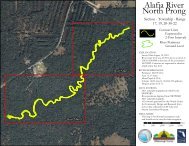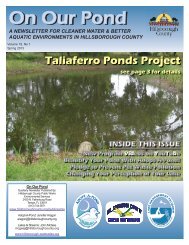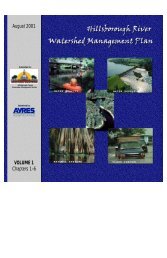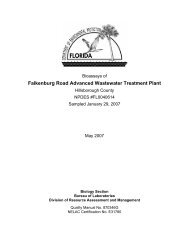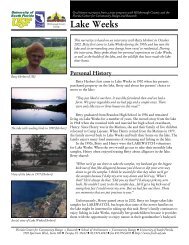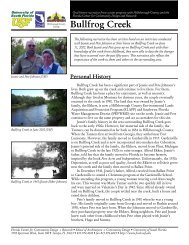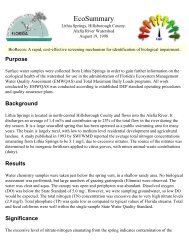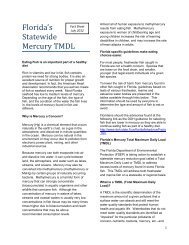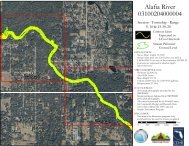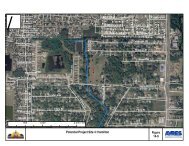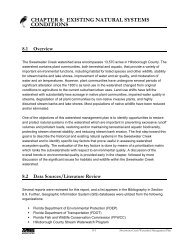Rocky Brushy Creek Watershed Mgmt. Plan (2007) -- Part 2
Rocky Brushy Creek Watershed Mgmt. Plan (2007) -- Part 2
Rocky Brushy Creek Watershed Mgmt. Plan (2007) -- Part 2
You also want an ePaper? Increase the reach of your titles
YUMPU automatically turns print PDFs into web optimized ePapers that Google loves.
CHAPTER 8the entire surface of some artificial ponds.Cogon GrassCogon grass is a non-native grass with extensive rhizomes,spreading stems from 3-10 feet. It is one of the most aggressiveweeds of dry lands in Florida, but can occur in areas that becomebriefly flooded. It can cover large areas. Native to the warmer regionsof the Old World, it was brought to the U.S. as experimental forage. Ithas spread, partially through its use as a packing material. It iscommonly seen along roadsides, ditches, swales, and abandonedland. Difficult to eradicate due to its hardy rhizomes, the plant quickly out competes most nativegrasses. It is most prevalent along roadsides and abandoned land in the watershed.Punk Trees (Melaleuca)Melaleuca trees, also known as punk trees or paperbark teatrees, are native to Australia, New Guinea, and New Caledonia.Melaleuca is characterized in Florida by a rapid growth rate,efficient reproduction, and the ability to invade a wide variety ofhabitats (Meskimen, 1962). This exotic tree grows alongroadsides, on ditchbanks, in mesic prairies, in sawgrassmarshes, and on lake shorelines. Once established, trees formdense stands that are nearly impenetrable (Center and Dray,1986). More than 4,000 trees per hectare are not uncommon inmelaleuca forests. Melaleuca is a pest, especially in the Everglades and surrounding areas, wherethe trees grow into immense forests virtually eliminating all other vegetation. Although smallmammals seem to use these forests, species diversity in wet prairie-marsh ecosystems with densemonocultures of melaleuca decreases by 60-80% (Austin, 1978; Woodall, 1978; Mazzotti et al.,1981). Schortemeyer et al. (1981) reported that only 10% of the bird species in melaleuca standsactually fed there and only 1.5% of their activity involves nesting in these trees. Melaleuca canreplace native pond cypress. Punk tree are seen as small clumps distributed in the lower reachesof the watershed in residential areas and on the margins of the salt marsh in the <strong>Rocky</strong> <strong>Creek</strong> andChannel A estuaries.Chinaberry TreeChinaberry is a naturalized, fast-growing tree in thesoutheastern U.S. It is invading the forests, fence lines,and disturbed areas of Florida and elsewhere,including Hawaii. Belonging to the mahogany family ofplants, chinaberry is native to Asia. Striking andcolorful, chinaberry was widely introduced as anornamental shade tree because of its large compoundleaves, distinctive clusters of lilac-colored flowers, andround yellow fruits. Chinaberry seeds are spread by fruit-eating birds. Chinaberry outgrows,8-39<strong>Rocky</strong>/<strong>Brushy</strong> <strong>Creek</strong> <strong>Watershed</strong> Management <strong>Plan</strong>



